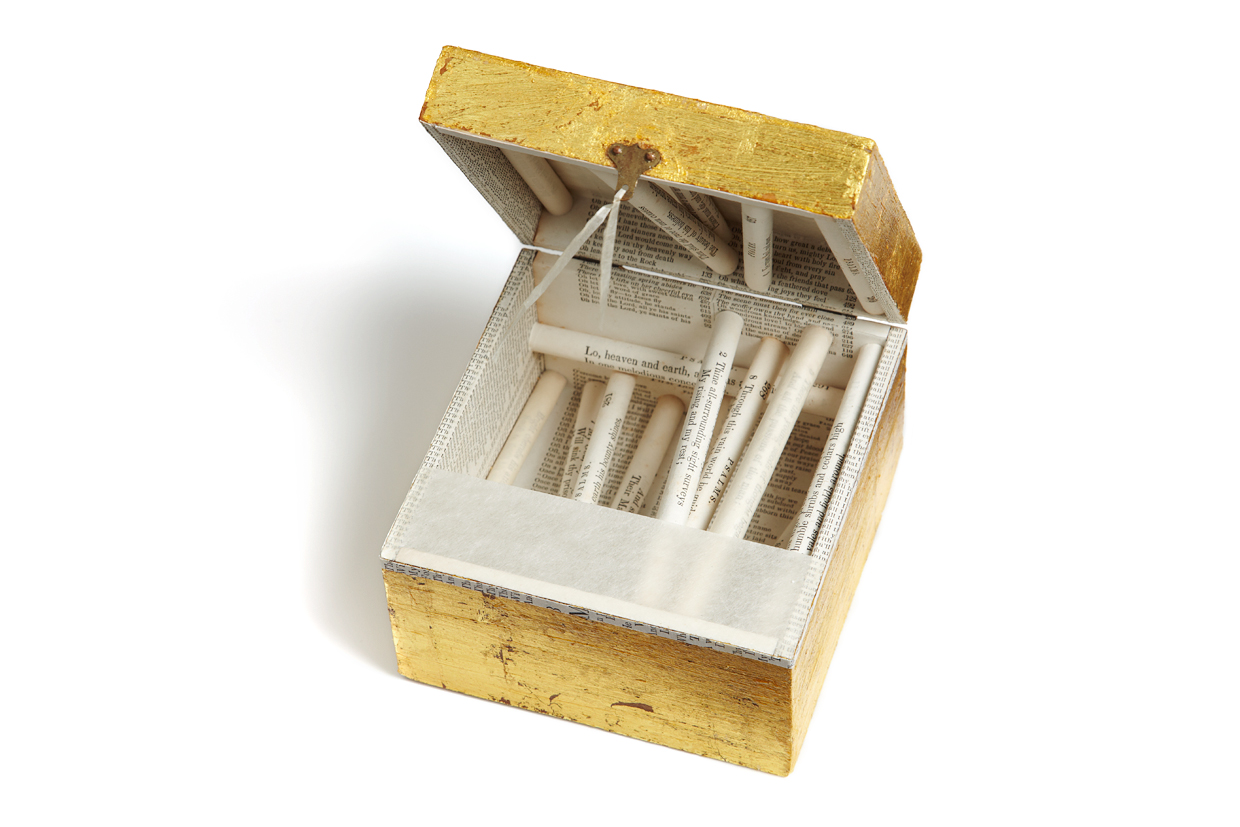

















Sacred Poems
"Carole has taken an 1844 Psalm book used in the churches for religious purposes, sliced it into a series of thin strips which are then rejoined, reconnected on her sewing machine. As she sews the pieces back together however, they've been interleaved with extremely fine tissue or leaves of gold to create these beautiful organic shapes in which the words no longer are the reason for the psalm book. It becomes a celebration of life and beauty that’s contained within them. Carole’s work is very understated, it’s very subtle and I think it bears close examination. It is one of the works that I think talks to the component aspects of paper. It is not about drama, it is about the quiet mood that these materials can also inspire."
-David Revere McFadden, Chief Curator
Museum of Arts & Design, NY, NY, Slash: Paper Under the Knife.
A book is not only the way in which text is presented but is is a container. An irreplaceable aspect of the book is that books absorb histories. Paradoxically the limitations of the form/codex presents us with important converstaions, intimiacies and possibilities for expansive experiences.
The primary element used in this series is paper: the pages are taken from a Parish Psalmody dated 1844 and 1849. These pages of psalms are manipulated and recombined, resulting in a presentation that evokes an ecumenical offering – poems of praise and gratitude. The disintegrating pages suggest the temporal quality of our lives and the vulnerability of memory and history. Utilizing both a reductive and additive process, embracing its inherent qualities while transforming the book’s pages, the paper itself gains significance through the process and merges with a new intent.
Visually there is a consistent and measured cadence to a page of psalms which is echoed in the repetitive weaving or restructuring of the paper: pages are cut in strips and woven creating an altered dense surface; multiple pages are stitched together and the shredded edges form new textural references; the layering of translucent tissue over the paper softens the effect of age and context, evoking the ephemeral while adding a veil of alternative possibilities. Although fragile the paper is surprisingly resilient. In a number of the pieces the use of stitching emphasizes the repetition of the lines of text. The lines of stitching are suggestive of the passage of time, alluding to the age and the history of these pages. The continuing repetitive action of sewing, knotting and weaving is similar to reciting, singing, and reading: implying that through the repetition of a task or ritual one has the possibility to transcend the mundane. The use of gold leaf elevates and heightens the rich textural qualities presenting a sumptuous visual experience. The interplay alludes to the enticing presentation of illuminated texts historically. Explored and displayed in this visual context, the alteration of the papers’ linear, tactile, and facile nature emphasizes transformation, while the possibility of revelation is playfully realized.
The intended use, as well as the nature of a psalm as spiritual repository, both imply a tradition of careful devotion and pious reverence. The physical text evocatively and powerfully serves as a gateway to an experience of the sacred and the realization of the latent power of the written word. This process of interaction is played out visually in the piece, mimicking the internal experience. Thus, through the individual evolution of each page, culminating in a transformation of the whole volume, the material and the conceptual interface delicately and suggestively with one another.
The Sacred Poem series takes physical, material, and intellectual inspiration from Parish Psalmody. A Collection of Psalms and Hymns for Public Worship, published in 1844 and 1849.